I finished my Rick Steves GAS (Germany, Austria, Switzerland) Tour today and had the whole day to explore Vienna. I’ve come to love the city and, as a bonus, feel like I’m still getting to know it. There is so much to see and do here and as I don’t do GAS often, I’ve had little chance to explore. I tackled two sights and one activity today: the KunstHausWien, the Hofburg New Palace Museums, and dinner in a suburban heuriger (HOY rig ur).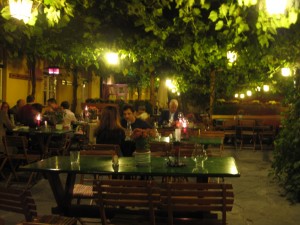
The New Palace Museums are OK but nothing that excited my imagination (Ephesis antiquities; arms and armor; musical instruments). The heuriger expedition was much more rewarding. Using Rick’s instructions and Vienna’s efficient and cheap public transportation, I headed out to the hills west of the city where I found lively courtyards with communal tables, live music, and great food and wine (very reasonably priced). All nested under latticed canopies of grape-bearing vines. It was a Wienerwald fantasy, only 30 minutes from the heart of the city.
However, the real revelation today was the KunstHausWien and nearby Hundertwasserhaus - together a fitting homage to the quirky, 20th century painter Friedensreich Hundertwasser. All I can say is WOW! I knew nothing about FH before today. Now I’m a fan! This is a great backdoor (“intention“) sight. FH was a sort of late 20th century, poor man’s Gaudi. The museum is housed in his last home and is a cross between Art Nouveau (Jugenstil in German) and Frank Loyd Wright.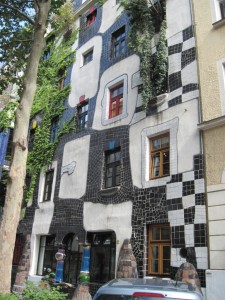 FH was a radical voice in art (got in a lot of trouble), an early environmental advocate (author of “The art of the Green Way“), and a colorful personality. He said man has three skins: our epidermis, our clothes (fashionistas take heart; I’m in trouble), and our homes. Living his philosophy, he made his homes blend with nature (roof/terrace gardens, undulating floors, organic forms, etc) and the museum was his last Viennese house. The building itself is worth the admission with a funky cubist exterior with “laughing windows“, an interior light well (ala Gaudi), a fountain (“all things flow”),
FH was a radical voice in art (got in a lot of trouble), an early environmental advocate (author of “The art of the Green Way“), and a colorful personality. He said man has three skins: our epidermis, our clothes (fashionistas take heart; I’m in trouble), and our homes. Living his philosophy, he made his homes blend with nature (roof/terrace gardens, undulating floors, organic forms, etc) and the museum was his last Viennese house. The building itself is worth the admission with a funky cubist exterior with “laughing windows“, an interior light well (ala Gaudi), a fountain (“all things flow”), ceramic columns, architectural models of planned developments which connote the Hobbiton of the Lord of the Rings movies,
ceramic columns, architectural models of planned developments which connote the Hobbiton of the Lord of the Rings movies,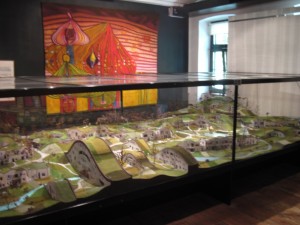 photos of FH, and the most welcoming museum café I’ve ever seen.
photos of FH, and the most welcoming museum café I’ve ever seen.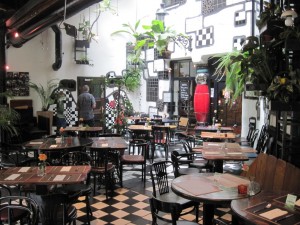 Oh, and tons of his pithy sayings ("A straight line is godless.") and dramatic paintings - did I mention he was primarily a painter? His art is a combination of 60s pop art and the black light posters I had on my walls in the 70s, with a smidge of Munch’s “The Scream” added for punch. It is bright, dramatic, visceral, and easily enjoyed if not completely understood.
Oh, and tons of his pithy sayings ("A straight line is godless.") and dramatic paintings - did I mention he was primarily a painter? His art is a combination of 60s pop art and the black light posters I had on my walls in the 70s, with a smidge of Munch’s “The Scream” added for punch. It is bright, dramatic, visceral, and easily enjoyed if not completely understood.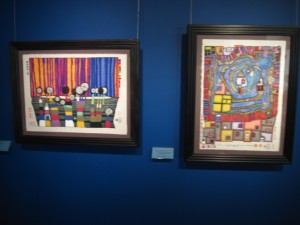 I liked it a lot. This is a no-miss sight in my book.
I liked it a lot. This is a no-miss sight in my book.
A 5-minute walk away is Hundertwasserhaus, FH’s attempt at architectural planning: more funkadelic checkerboard exteriors, tree tenants (“ambassadors of the forest“), and organic forms. As a pleasing visual oddity it’s a success. As an apartment building it was a failure. In a synchronous event (see my previous blog on synchronicity), I stumbled by accident upon one of FH’s only other buildings in Vienna - a power plant. I was intrigued by the model I’d seen in the museum but thought that Spittelau was far, far out of the center. Imagine my surprise when I saw it from my train window (mind you, a subway train that emerged from underground for single stop) on my way to the Heurigen neighborhood on the outskirts of town. I hopped off the train, took a couple of snapshots (perfect lighting at that time of day) and caught the next ongoing train.
As a pleasing visual oddity it’s a success. As an apartment building it was a failure. In a synchronous event (see my previous blog on synchronicity), I stumbled by accident upon one of FH’s only other buildings in Vienna - a power plant. I was intrigued by the model I’d seen in the museum but thought that Spittelau was far, far out of the center. Imagine my surprise when I saw it from my train window (mind you, a subway train that emerged from underground for single stop) on my way to the Heurigen neighborhood on the outskirts of town. I hopped off the train, took a couple of snapshots (perfect lighting at that time of day) and caught the next ongoing train.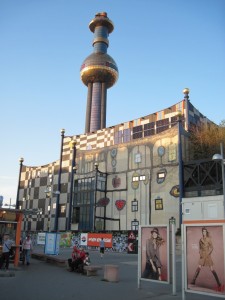
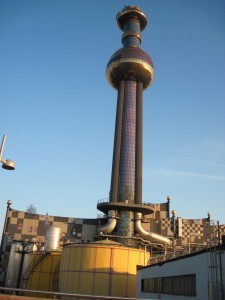 As stated at the outset, I loved Vienna already. But like other world class cities she has layers upon layers and requires several visits to reveal them.
As stated at the outset, I loved Vienna already. But like other world class cities she has layers upon layers and requires several visits to reveal them.
